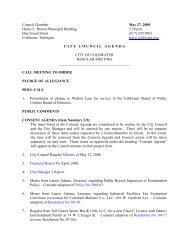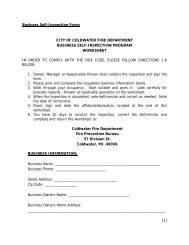Landlord Tenant Guide - State of Michigan
Landlord Tenant Guide - State of Michigan
Landlord Tenant Guide - State of Michigan
- No tags were found...
Create successful ePaper yourself
Turn your PDF publications into a flip-book with our unique Google optimized e-Paper software.
The landlord must either:a) Deposit the money with a regulatedfinancial institution (e.g., bank), ORb) Deposit a cash bond or surety bond, tosecure the entire deposit, with the Secretary <strong>of</strong><strong>State</strong>. (Note: If the landlord does this, he or shemay use the money at any time, for anypurpose.) The bond ensures that there ismoney available to repay the tenant’s securitydeposit. The security deposit is considered thelawful property <strong>of</strong> the tenant, until the landlordestablishes a right to it—generally by obtaininga judgment in a court <strong>of</strong> law.If the landlord sells the rental property, heor she remains liable with respect to thetenant’s security deposit until any ONE <strong>of</strong> thefollowing occurs:a) The landlord returns the deposit to thetenant, ORb) The landlord transfers the deposit to thenew owner and sends notice—by mail—to thetenant informing him or her <strong>of</strong> the new owner’sname and address, ORc) The new owner sends written notice <strong>of</strong>their name and address to the tenant AND thename and address <strong>of</strong> the financial institutionwhere the deposit is held AND the tenant’sobligation to provide a forwarding addresswithin 4 days <strong>of</strong> terminating occupancy. The landlord must provide the tenant withcertain notices. Within 14 days from the daythe tenant moves in, the landlord must providewritten notice <strong>of</strong> the following:a) The landlord’s name and address forreceipt <strong>of</strong> communications regarding thetenancy;b) The name and address <strong>of</strong> the financialinstitution where the security deposit is held,OR the name and address <strong>of</strong> the suretycompany; and who filed the bond with theSecretary <strong>of</strong> <strong>State</strong>; andc) The tenant’s obligation to provide aforwarding address—in writing—within 4 daysafter the tenant moves out.Generally these notices are found in thelease itself. (See The Lease section; see alsothe model lease in the Appendices, whichdisplays all <strong>of</strong> these notices with the correctform and wording.) The checklist preserves some pro<strong>of</strong> <strong>of</strong> thecondition <strong>of</strong> the property when the tenantmoved in. The landlord must provide thetenant with 2 blank copies <strong>of</strong> an inventorychecklist, referencing all items in the rentalunit. The landlord must provide written noticeon the first page <strong>of</strong> the checklist that thetenant must properly complete the checklist,noting the condition <strong>of</strong> the property, andreturn it to the landlord within 7 days aftermoving in. (See sample, page 41.)The tenant may request a copy <strong>of</strong> thetermination inventory checklist (generallyreferred to as the itemized list <strong>of</strong> damagescaused by the previous tenant). If requested,the landlord must provide a copy to thetenant. Yes. The checklist preserves some pro<strong>of</strong> <strong>of</strong>the condition <strong>of</strong> the property when the tenantmoves in. If the tenant fails to properly fill outthe checklist, or fails to return it, and a disputeover damages to the property occurs at theend <strong>of</strong> the lease, it becomes the tenant’s wordagainst the landlord’s word.Further recommendation:Take photos or video tape recordings <strong>of</strong> therental unit before tenant moves in.





